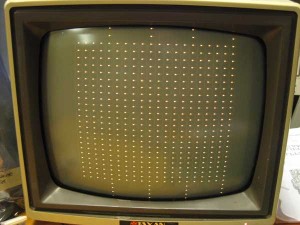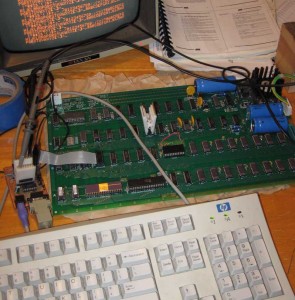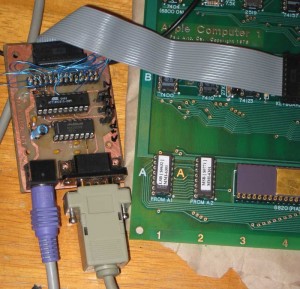There is a small flaw in the video section of the Apple 1, that causes spikes in the video signal. This results in extra pixels in the display. Here is a worst case display, with brightness turned way up, of those pixels, with no characters displayed ( the screen should be blank).

I have been able to confirm with some help that this fault also occurs on the Obtronix and original Apple Is. I’ve tracked this down to cross talk between the video signal from C13-6 to the 3K resistor and CLK03, which feeds the 2504s clocks. These two signals share adjacent traces across the top of row D, just above the large ground trace.
Wendell S. has done some further analysis and has determined that the fault is caused by the high impedance nature of the video output circuit. Wendell writes “The node driving the 3K can be very high impedance when both C13-6 and D1-13 are high so the network is very susceptible to pick-up as you described (nice catch!). The impedance of the node is set by the base current of Q5 as it pulls down the emitter followers in the TTL outputs.”
I’ve ordered some transistors with lower Beta in order to see if I can eliminate this noise. I also did a quick test by pulling down the output C-13, Pin 6, with a 2.2K resistor and as expected, the noise completely disappeared. Another fix is to bypass the trace by lifting one leg of the 3K resistor and C-13, pin 6 and running a jumper wire, avoiding the crosstalk.
Along with the aforementioned lower beta transistors, I’ve ordered some capacitors that I hope more closely mimic the originals. The assembly manual is also moving along, though I had a bit of a setback recently, when I accidentally put the whole manual into a bullet type format. I’m still undoing that. I’ll put a PDF version online once I finalize it.
I’ve been getting a number of inquiries about bare boards and kits. Bare boards should be shipping in about a week and will cost $150. Kits should be ready about a week after that and will cost $666.66.
Folks that are on the wait list will get first chance to order. I may have to order a new batch of boards, before I get completely through the wait list. Delivery of my first batch was pretty quick, about 2 weeks, so I don’t expect huge delays if I do run out.


